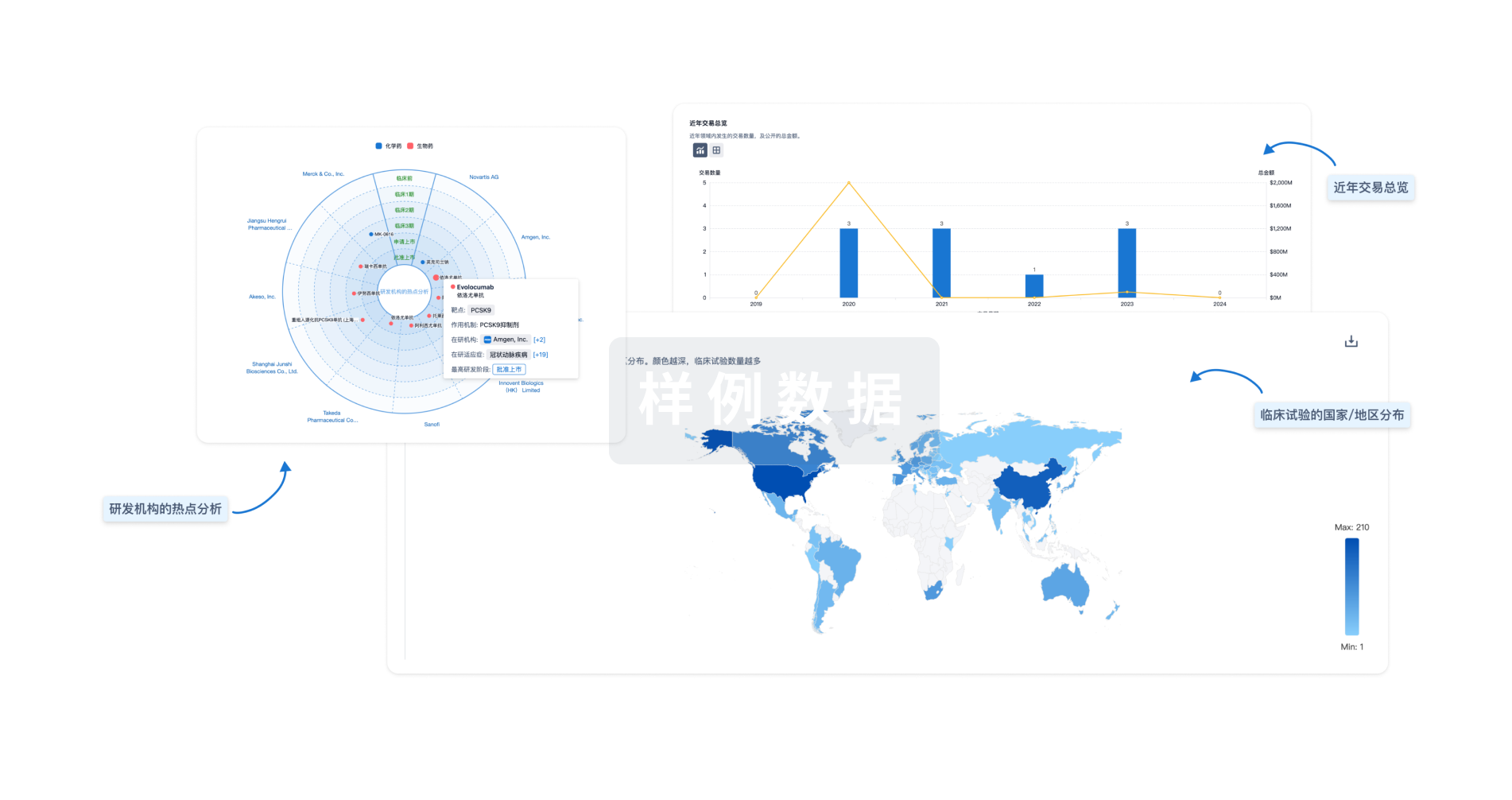预约演示
更新于:2025-05-07
RPL3
更新于:2025-05-07
基本信息
别名 60S ribosomal protein L3、HIV-1 TAR RNA-binding protein B、L3 + [4] |
关联
100 项与 RPL3 相关的临床结果
登录后查看更多信息
100 项与 RPL3 相关的转化医学
登录后查看更多信息
0 项与 RPL3 相关的专利(医药)
登录后查看更多信息
763
项与 RPL3 相关的文献(医药)2025-05-01·Journal of Autoimmunity
Exploring the correlation between UVB sensitivity and SLE activity: Insights into UVB-driven pathogenesis in lupus erythematosus
Article
作者: Guo, Yuanning ; Xu, Jinhua ; Chen, Jiamin ; He, Jiayu ; Zhu, Xiaohua
2025-01-01·International Journal of Biological Macromolecules
Construction of novel 10 signatures in diabetic retinopathy construction of model based on WGCNA: Mechanism of action of RPL3 and MRPL16 protein
Article
作者: Xiaojing, Sun ; Li, Ma
2025-01-01·European Journal of Gastroenterology & Hepatology
Sarcopenia is associated with new-onset acute biliary infection within 1 year in patients with hepatitis B virus-related decompensated cirrhosis
Article
作者: Zhou, Tian ; Zhang, Shuangshuang ; Xiong, Xuanxuan ; Wu, Mingbo
8
项与 RPL3 相关的新闻(医药)2025-04-16
·智慧芽
Agent(智能体)已成为AI领域的下一个战场。日前,作为AI驱动的科技创新与知识产权信息服务领域的领军企业,智慧芽宣布即将发布更懂技术创新的AI Agent平台Eureka,开启全新AI战略。独立前沿科技研究机构“未尽研究”采访智慧芽,未尽研究创始人周健工与智慧芽创始人兼CEO张济徽,围绕AI时代SaaS商业模式转型,垂直领域AI Agent发展机遇,智慧芽AI战略,以及AI对企业研发和科学研究所产生的深远影响等话题,展开深度对话。以下是精选访谈实录1AI大时代真正来临DeepSeek后AI万众期待周健工:春节前,我遇到各行各业的人,都在谈AI,但都是以一种看热闹的方式在谈。但春节之后再谈AI,各行各业都是真的想真金白银,拿点钱去试一把,拥抱AI。张济徽:是的。春节回来之后,过去一两个月约不上的企业客户高管,现在都约得上了。很多客户的高管都很愿意说,你们过来给我们讲讲这个AI怎么用。AI时代的商业模式和SaaS创新周健工:B2B SaaS,B端的订阅制,主要看卖多少个账户。AI时代,SaaS的服务模式,还有获客的方式,会带来哪些变化?张济徽:行业里本来都有转型的趋势,不过因为AI,我觉得加速了。以前SaaS通常是以账号形式收费,公司有多少个员工,就买多少个账号。可是很多时候他们买了账号,一年可能用个5次、10次、20次,但还是付一整年的钱。现在因为AI的到来,可能就会通过调用它的次数、token、积分,或者按完成任务的次数等来收费。你对客户带来多少价值,客户就买单付多少钱。我相信这是接下来的商业模式、收费模式的重要趋势。对应来说,对于我们这些SaaS供应商的要求也就更高了。你要确保做出来的产品,用户是天天用,能消耗这些用量,才会真正让他买单。周健工:最近OpenAI说,可能将来提供一个博士级的模型或者Agent,一个月收2000美元,因为它可以代替一个高级的研究人才,你们会往这个方向走吗?我感觉研发领域是特别适合往这个方向走的。张济徽:都有在探讨。因为流量模式的弊端是对于客户来说,他可能不清楚到底需要多少流量,应该买多少流量,那就会导致整个销售周期拉长。所以现在我们会提供“混合模式”,还是以账号的形式售卖,但用量上会设定一个“软上限”。2AI Agent时代的垂直领域机遇通用Agent很强大,为何还需要垂直Agent?周健工:现在其实我也听到,不少人对Agent有批评的声音。就是说Agent它都是在一些基座模型上面建立起来的,但基座模型现在依然有很多不完善的地方,比如说幻觉、记忆力,以及在世界模型方面的欠缺。Agent从thinking到action之间,尤其是跟外部世界的互动,包括多模态等,还是有待发展的。你们在开发Agent,给用户提供服务的时候,有没有遇到这样的问题?张济徽:因为我们是在垂直领域提供Agent,所以这个范围就框起来了。比如用户要求“帮我把今天最热门的科技新闻里面提到的技术,用专利分析,然后总结亮点”。对于这样一句要求,大模型识别了这句话的意图,把它拆成几块任务,比如找科技新闻,就分配给谷歌新闻检索Agent,专利分析分配给智慧芽专利分析Agent。所以现在让AI来拆解和分配任务,这个范围是很狭义的,所以它的幻觉还好,是能解决的。再比如,谷歌有翻译功能,但我们在专利方面的翻译就做的比谷歌好,因为我们用特别多专利术语等来翻译,这其中还是存在专业壁垒的。AI Agent为什么不直接进入L5阶段?周健工:我最近看到一篇论文,它对Agent做了一些总结,我觉得挺有意思。它说以前人们都把大模型当Agent用了,但实际上大模型不是Agent,只是一个engine(引擎)。就像开车一样,光靠engine是不能让你去驾驶得很好,除了engine之外,必定还要有其他的功能和部件。张济徽:其实OpenAI的deep research,它背后就用了很多Agent串起来去做。再像我们服务专利领域,其中一类客户是专利代理人,他的工作中需要撰写“查新报告”,去对比分析没有相似的专利。这个你可以理解成相对于deep research,更细分的一种场景。也正是因为更细分了,所以我们的Agent能做的更精准、更聚焦。周健工:现在Agent会在执行工作任务之前,先把问题跟你定义地更清晰一点,核实一下然后再去做。张济徽:这种交互方式的确会更好。现在就算技术上一下子能把产品真的做得到类似自动驾驶领域所说的L4、L5级别,用户可能都不相信、不信任。你要让用户慢慢地从L2、L3开始适应,多一点互动,让用户感觉自己是在驾驶舱,而不是在副驾驶。让用户有掌控感了,那时间久了,就慢慢信任了,未来就能用Agent做完全部任务了。AI Agent先解决效率问题?周健工:你们虽然能够把在当前技术条件下最好的产品提供给他们。但是用户在用的时候,有时候要求是比较苛刻的。尤其是做科研研发,要求准确率非常高,你觉得现在到这个程度了吗?如果没有到这个程度,跟用户需求之间的矛盾是怎么去解决的?张济徽:比如在IP场景中,首先要证明通过Agent来完成工作任务,比过去传统的方式来完成是更高效的。像是专利代理人,以前他们可能用一两天做一份报告。而现在通过Agent,生成同等质量的报告,只需花半小时到一小时。这其中的ROI提升是很明确的。所以现在很多专利代理所,都已经愿意买单了。当然技术还在持续迭代,可是现在这些Agent已经实实在在能帮助客户降本或者提效,那他就已经愿意买单了。同时,我们也会跟着技术的发展,一直持续提高我们Agent的准确性,降低幻觉等。3智慧芽AI路径:专注技术创新更懂技术创新的AI Agent平台周健工:你们现在在服务通用研发,是服务企业的整个研发工作链路吗?换句话说,你们提供的是类似R&D machine的产品,还是说只是R&D machine里面的一个工作流或者一个子域?张济徽:这个会从短、中、长期来看。即便外部已经有了很多材料或者生物医药大模型,但在短期内,因为专利数据的挖掘及其AI化还是我们的强项,所以还是先在与专利文献相关的生物序列或者化合物成分等领域去发力。等这些能力成熟后,的确可以跟外部AI相结合。现在有新的一个协议叫MCP协议,就是Agent和Agent沟通的协议。所以,我给团队的目标就是,今年年底前,先把跟专利相关的Agent做到全球第一。AI Agent平台也是AI社区张济徽:我们已经搭建了一个技术创新领域的AI Agent平台Eureka。先把过去十几年积累的成熟能力做成AI Agent,比如生物序列检索、化学式检索等,能够在Eureka平台上调用。不过只是我们提供Agent还不够,未来会接入第三方的AI能力。其实这在内部已经内测上线了,接下来人人都能创建Agent。比如前面提到的,用户想要找把今天最新的热门的科技新闻分析一下,找到里面的科技亮点。这个任务执行的背后,就是由各种Agent能力协同组合起来,变成一个完全满足特定场景的Agent。具体调用的可能是我们的Agent,也可能是第三方比如谷歌的Agent,我觉得会是重要趋势。周健工:哪些领域你们会重点发力呢?张济徽:我们的AI Agent平台Eureka有四条主线:第一条线是IP(知识产权),包括查新、FTO侵权分析……;第二条线是通用研发,就是帮助研发人员更好地寻找技术方案,服务制造业、高端制造等领域的研发场景。我们加入了一些技术发明的原理去训练AI。第三条线是生物医药,其中不仅仅专利,还包括靶点、基因序列、临床等数据相关的场景。第四条线就是材料。面向中国市场的,支持AI本地部署周健工:SaaS服务通常是提供给客户账号就行了,但现在很多客户又想要本地部署,想拿他的数据去RAG一下,这些你们都要做吗?还是说你们会找一个合作伙伴一起来做?张济徽:现在这个阶段我们先自己闭环。一方面,我们会持续开发和提供SaaS版本,也就是线上的AI智能体,让客户试用过后,觉得的确是好用的,是更高价值的。下一步,如果客户问这些智能体能不能放在他自己的服务器,在智慧芽提供的智能体的基础上,再加一些客户自己的过去积累的比如研发立项报告等。目前已经有客户买单了这种模式了。4AI的未来AGI之辩周健工: Anthropic的创始人Amodei谈过, 21世纪是一个压缩的世纪,以前花一个世纪所能完成的科学探索,现在可能用五年、十年就完成了。从你们业务的角度,你觉得make sense吗?张济徽:业内有一种反驳的声音是,如果这种观点是对的,那下一个“爱因斯坦”应该出现了。现在汇集了那么多信息、全球的知识,为什么还没有一个“爱因斯坦”能发明发现全新的理论呢?所以对于这个argument,我觉得也是有道理的。总体上,我觉得LLM还是通过大批的数据,statistically来统计说下一个词出现的是什么,会有它的一些局限性,当然目前的确已经很强大了。但如果要做到AGI,我个人觉得应该还要结合其他的能力。AI Agent带来组织进化周健工:未来是不是Agent组织化,会替代公司部门之间的组织化?企业里面以前更多的是人和人之间,部门和部门之间的协作。但很多工作流以后都可以自动化了,是不是Agent之间,就能Agent2Agent,组织化起来?张济徽:的确,以后靠Agent和Agent之间沟通协调,就能完成很多工作了。我在想象,比如十年后,或者我的下一代去创业,肯定就只需要几个人,而不是招1000个人去创业了。科技信息服务赛道的新竞争周健工:你会不会担心,突然间中国或者国外出现一个AI原生的科技情报服务的竞争对手?张济徽:我觉得真正可能会来disrupt颠覆的,是来自这种做大模型的厂商。现在deep research,已经达到了类似麦肯锡中一位associate级别的员工,直接能做一份有深度的报告了。所以随着大模型持续迭代,它们的能力跨越和发展,是我觉得要重点关注的。不过对于垂直领域而言,我觉得还是存在垂直领域的壁垒的。比如专利领域,我们毕竟积累了这么多年的加工处理过的专利数据。一个大模型无论多厉害,智商多高,有些垂直领域数据没有接触过,就是不能自己想象出来。所以我觉得这一块还是会存在壁垒的。当然我们也是在持续关注,不是说我们有这批数据,就肯定很安全了,还是要紧紧跟着技术迭代的步伐去走。AI是机遇和风险并存的。Deepseek这一波带来的好处是,它把我们很多客户都教育了一遍,让他们意识到原来是可以这么用AI的。不过他们实际用的时候也就会发现幻觉等问题。那这就是我们要持续迭代,持续发力的点,要在这种特定工作场景,让我们AI的幻觉达到更低,成为我们的优势。我觉得只要跟着AI技术的发展,相信总能博弈到一个适合我们的空间。更多精彩 推荐阅读智慧芽通过国家网信办「双备案」智慧芽接入DeepSeek-R1大模型
引进/卖出
2025-03-01
导读:Gritstone bio成立于2015年,2018年9月IPO。Gritstone bio原名Gritstone Oncology,2021年更名为Gritstone bio,意味着公司从免疫肿瘤学公司转型为兼顾肿瘤和传染病免疫疗法的生物技术公司,公司在研管线也在癌症疫苗的基础上增加了传染病疫苗。GRANITE(GRT-C901/GRT-R902)是Gritstone开发的一款个体性新抗原疫苗,也是Gritstone的第一个肿瘤学项目。GRANITE被美国食品和药物管理局(FDA)授予快速通道用于治疗转移性微卫星稳定型结直肠癌(MSS-CRC)。目前,Gritstone正在开展一项2/3期研究,以评估GRANITE作为新诊断MSS-CRC患者维持治疗方案的有效性。
01
肿瘤新抗原疫苗GRANITE简介
个体化新抗原疫苗GRANITE的设计思路如下:对于入选的肿瘤患者,首先进行常规的临床活检。然后,研究人员对肿瘤样本进行测序,并应用Gritstone专有的EDGE™平台,预测出一组可能出现在患者肿瘤上的患者特异性新抗原。利用这些预测的新抗原,研究人员将设计一种包含相关新抗原的个性化疫苗,通过简单的肌肉注射给药。研究人员计划在社区肿瘤学环境中为癌症患者提供免疫疗法,绝大多数癌症患者都在这里接受治疗。
GRANITE疫苗包含两个关键组成部分:其一为GRT-C901,这是一种经腺病毒载体(ChAdV)递送的新抗原编码基因;其二为GRT-R902,是一种经LNP递送的、编码癌症新抗原的自扩增mRNA(saRNA)。GRT-C901和GRT-R902表达相同的20种个性化新抗原以及两种通用CD4 T细胞表位(PADRE和破伤风类毒素)。GRANITE疫苗的接种方案是先使用GRT-C901作为初次免疫,再使用GRT-R902作为加强免疫,以充分刺激免疫反应。
图1 GRANITE的设计思路
02
GRANITE相关专利汇总
在“google patent”中,菌菌检索到Gritstone发布的多项关于GRANITE疗法的专利,汇总如下表所示。专利涵盖了癌症样本的测序、肿瘤新抗原疫苗的序列设计思路和递送系统等。
下文中菌菌将聚焦于GRANITE中GRT-R902(saRNA成分),解析其序列特征和递送系统。
表1 GRANITE相关专利汇总
03
GRANITE中saRNA成分解析
Gritstone在多项专利中公开了GRT-R902(即saRNA部分)的序列和递送特征。以WO2021092095A1(US20230020089A1)为例,详细描述了saRNA的自复制骨架序列、抗原编码序列和LNP递送系统。
3.1 saRNA疫苗的自复制骨架
专利所描述的saRNA自复制骨架来源于甲病毒(alpha病毒)系统,其中非编码序列来源于甲病毒保守序列元件(CSE),由5’端到3’端依次为甲病毒来源的5’ UTR(51 nt CSE)、26S 亚基因组启动子序列(24 nt CSE)、3' UTR(19 nt CSE)和3' poly(A)尾。saRNA的第一编码区为RNA复制酶(即甲病毒来源的非结构蛋白nsp 1-4)。以上组成了saRNA疫苗的复制子骨架。
具体来讲,该saRNA序列骨架来源于委内瑞拉马脑炎病毒(VEEV),保留其非编码序列和非结构蛋白编码序列,将VEEV结构蛋白编码序列替换成目标蛋白编码序列。
图2 VEEV来源的saRNA骨架序列
3.2 saRNA疫苗的编码序列
saRNA疫苗的第二编码区为个体化肿瘤新抗原编码序列,具体氨基酸序列来源于对患者肿瘤样本的测序和表位预测。与初次免疫的腺病毒载体疫苗一致,saRNA编码20种个性化新抗原(MHC I类)和两种通用的CD4 T细胞表位PADRE和破伤风类毒素(MHC II类)。不同抗原表位以“(L5-N-L3)20-(G5-U)2-G3”的形式串联,L5、L3、G5和G3均为接头序列。
专利列举了支持临床前IND研究的抗原表达盒,并显示了所用T细胞表位的序列信息。
图3 个体化肿瘤新抗原表达盒
3.3 saRNA疫苗的递送系统
saRNA包封在由4种脂质组成的LNP中:可电离氨基脂质、磷脂酰胆碱(DSPC)、胆固醇和PEG修饰脂质,其中可电离脂质为MC3或MC3样脂质。
图4 可电离脂质MC3结构示意图
04
结语
GRANITE是一种创新型的个体性肿瘤新抗原疫苗,在临床前模型和临床试验中验证了基于腺病毒(GRT-C901)和saRNA-LNP(GRT-R902)这两种新抗原载体进行初次免疫和加强免疫,能够充分激活T细胞免疫反应,从而杀伤肿瘤细胞。
而从saRNA部分的设计策略来讲,GRT-R902与首款上市saRNA疫苗ARCT-154的设计策略基本一致。二者均采用了甲病毒来源的复制子骨架:5’ UTR、RNA复制酶、26S亚基因组启动子、3’ UTR和3’ poly(A)尾。同时,GRT-R902和ARCT-154均采用了LNP这一经临床验证的递送系统。
参考文献
[1] Gritstone bio. Shared neoantigen vaccines. WO2021092095A1 / US20230020089A1.
识别微信二维码,添加生物制品圈小编,符合条件者即可加入
生物制品微信群!
请注明:姓名+研究方向!
版
权
声
明
本公众号所有转载文章系出于传递更多信息之目的,且明确注明来源和作者,不希望被转载的媒体或个人可与我们联系(cbplib@163.com),我们将立即进行删除处理。所有文章仅代表作者观不本站。
疫苗信使RNA免疫疗法快速通道
2024-11-15
·精准药物
引言
在药物发现领域,分子胶作为一种新型治疗手段,能够稳定蛋白质-蛋白质相互作用(PPI),从而有效靶向那些传统上难以成药的蛋白质。下面介绍的这篇文章详细研究了分子胶降解剂的协同结合机制,特别是针对cereblon(CRBN)调节剂靶向Ikaros家族锌指蛋白2(IKZF2)的分子胶。IKZF2是一种在癌症免疫疗法中扮演重要角色的转录因子。研究作者与背景
本研究由伦敦大学物理学院与天文学系的Balint Dudas、Edina Rosta博士以及阿斯利康蛋白质结构与生物物理部的Christina Athanasiou、Juan Carlos Mobarec博士共同完成。这些作者在分子胶研究领域具有丰富的经验,致力于通过计算生物学和结构生物学的方法,探索和开发新型的治疗策略。
该研究的成果已在ChemRxiv预印本上发表,旨在提供一个全面的计算模型,以筛选大型分子库,从而识别出高效的分子胶候选分子。这项研究不仅展示了分子胶在靶向蛋白质降解方面的变革潜力,同时也为药物发现中的创新治疗策略铺平了道路,具有重要的科学和临床意义。
研究内容
理论基础
协同性与分子胶设计:协同性是分子胶稳定三元复合物的核心,即使二元相互作用较弱,也能促成稳定的三元复合物的形成。基于热力学关系,协同性被重新定义,并通过结合自由能的差异来量化。
实验数据与计算模型
实验数据对比:科学家们对CRBN-IKZF2复合物的实验数据进行了基准测试,验证了计算模型在识别优越分子胶方面的准确性。
高通量筛选:通过大规模筛选,我们从广泛的化学库中鉴定出新的候选分子,并采用先进的自由能扰动(FEP+)模拟进行了验证。
结果与讨论
三元复合物中的结合亲和力:研究表明,L4和L5在形成稳定的三元复合物方面表现最佳,与实验数据相一致。
协同效应:计算结果显示,L1是L1-L5中效力最弱的配体,而L4和L5因其显著的协同性而位居前列。
分子基础与选择性
IKZF降解剂的差异:分析不同配体在三元复合物中的相互作用时,我们发现带正电荷的L4和L5与CRBN的E377残基之间的强烈相互作用至关重要。
IKZF2亚型的选择性:L0(pomalidomide)对IKZF1具活性,而L5则被开发为选择性IKZF2降解剂。
上图展示了不同配体(lig0到lig5)与CRBN残基及IKZF2残基之间的相互作用能量(IntE)。可以观察到,配体L5与E377残基之间的相互作用特别强,这可能是由于L5带正电荷,与带负电荷的E377形成了强烈的静电相互作用。L4和L5显示出比L0-L3更强的相互作用,这表明它们可能更有效地作为分子胶候选分子。L4与E137残基之间的相互作用特别强,这可能是由于L4的带电胺基与E137形成了盐桥。L4和L5再次显示出比L0-L3更强的相互作用,这与它们在实验中观察到的粘性性能一致。虚拟筛选
发现IKZF2降解剂:通过子结构搜索,找到与L0-L5相似的配体,并通过模拟和FEP+模拟验证了它们的结合亲和力和协同效应。
上图展示了子结构搜索命中的预测协同性和相互作用能量,以及实验降解剂和参考配体L0和L5的数据。图中还显示了排名靠前的配体的二维结构。结语
本研究开发并验证了一种基于自由能计算的稳健计算框架,用于从广泛的分子库中识别靶向IKZF2的强效分子胶降解剂。
研究结果表明,通过子结构搜索和计算化学方法可以有效地筛选和发现新的分子胶降解剂。这些新发现的配体在理论上可能具有比现有药物更好的性能,为开发新型蛋白质降解剂提供了新的思路。
声明:发表/转载本文仅仅是出于传播信息的需要,并不意味着代表本公众号观点或证实其内容的真实性。据此内容作出的任何判断,后果自负。若有侵权,告知必删!
长按关注本公众号
粉丝群/投稿/授权/广告等
请联系公众号助手
觉得本文好看,请点这里↓
免疫疗法引进/卖出
分析
对领域进行一次全面的分析。
登录
或

生物医药百科问答
全新生物医药AI Agent 覆盖科研全链路,让突破性发现快人一步
立即开始免费试用!
智慧芽新药情报库是智慧芽专为生命科学人士构建的基于AI的创新药情报平台,助您全方位提升您的研发与决策效率。
立即开始数据试用!
智慧芽新药库数据也通过智慧芽数据服务平台,以API或者数据包形式对外开放,助您更加充分利用智慧芽新药情报信息。
生物序列数据库
生物药研发创新
免费使用
化学结构数据库
小分子化药研发创新
免费使用